AMD Radeon HD 7870 GHz Edition & Radeon HD 7850 Review: Rounding Out Southern Islands
by Ryan Smith on March 5, 2012 12:01 AM ESTPower, Temperature, & Noise
As always, we wrap up our look at a new video card with a look at the physical performance attributes: power consumption, temperatures, and noise. Thanks to TSMC’s 28nm process AMD has been able to offer 6900 series performance on a much smaller chip, but what has that done to power consumption and all of its related properties? Let’s find out.
Please note that we’re including our 7870-based 7850 in these charts, even though none of AMD’s partners will be shipping a card in this exact configuration. Power consumption should be nearly identical to shipping cards, but temperatures and noise readings are going to be significantly different since most of those cards will be using open air coolers.
| Radeon HD 7800 Series Voltages | ||||
| Ref 7870 Load | Ref 7850 Load | Ref 7870 Idle | ||
| 1.219v | 1.213v | 0.85v | ||
When getting a voltage reading on our 7800 cards through GPU-Z, it was interesting to note that the load voltage was almost identical between the two cards: 1.219v versus 1.213v. While we believe GPU-Z is giving us the right readings, we’re not sure whether the 7850 voltages are the same we’ll be seeing on shipping cards because of the PCB differences.

Idle power consumption looks quite good, as you’d expect from GCN. Idle power consumption is virtually identical to the 7900 series at the wall, and only the 7700 series can beat 112W. This further goes to show just how much progress has been made with idle power consumption – the Cayman based 6900 series had good idle power consumption for its time, and yet the 7800 series beats it by 5W+ at the wall.
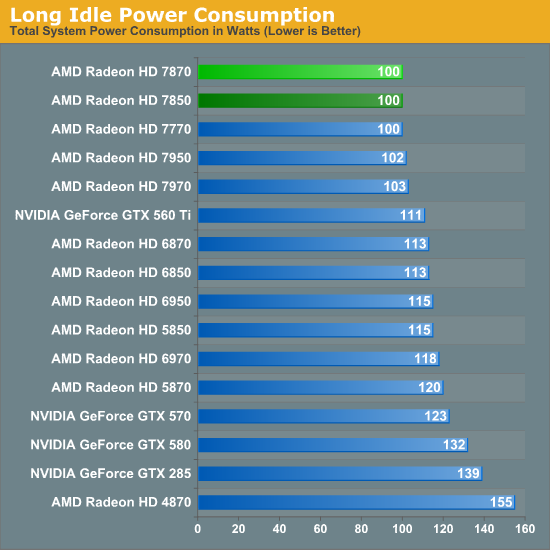
Long idle power consumption is virtually identical with the rest of the Southern Islands cards thanks to AMD’s ZeroCore Power technology. The next closest card is the GTX 560 Ti, and that’s at nearly 10W higher.
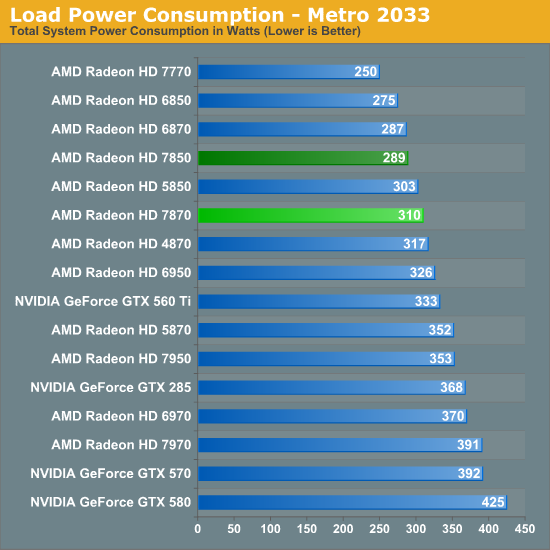
Moving on to load power testing, we have Metro 2033. Load power consumption here is about where you’d expect it to be, with the 7800 setups drawing more at the wall than the 6800 setups, but less than the 7900 and 6900 series. This is largely a consequence of performance, as the higher rendering performance of the 7800 series versus the 6800 series drives up CPU power consumption in order to generate more frames.
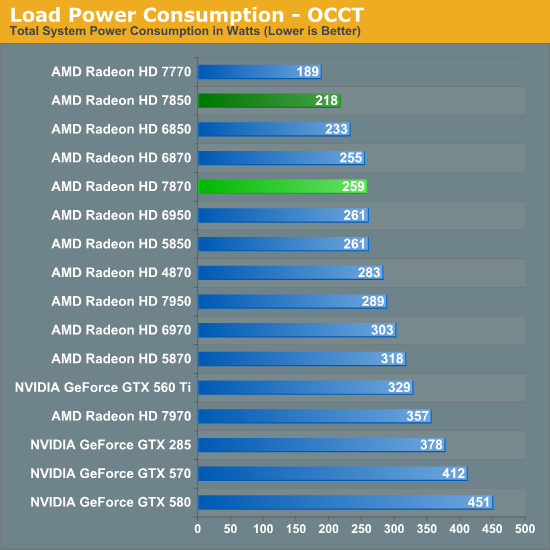
OCCT on the other hand gives us a more purified look at power consumption, and as you’d expect for 28nm it looks good. The 7870 ends up drawing only a few more watts at the wall compared to the 6870, showcasing the fact that the 7800 series is a drop-in replacement for the 6800 series from a power consumption perspective. The 7850 looks even better, capping out at 15W below the 6850, most likely as a result of PowerTune keeping the card firmly at 150W. Though it’s interesting to note that the measurements at the wall don’t perfectly align with the differences in PowerTune limits, with the 7850 drawing 30W more than the 7770 at the wall compared to a 50W PT difference, while the 7950 draws 30W more at the wall over the 7870 even though there’s only supposed to be a 10W PT difference.
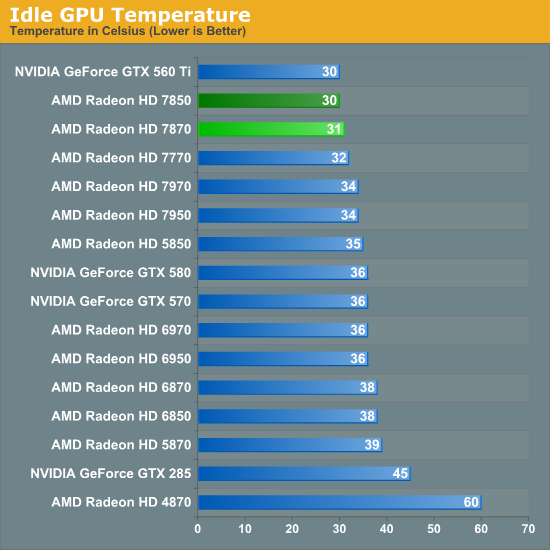
AMD’s latest generation blowers do quite well with idle temperatures and we can see it here. At 30C for the 7850 it’s every bit as cool as the GTX 560 Ti, while the entire 7800 series is around 5-8C cooler than the 6900.
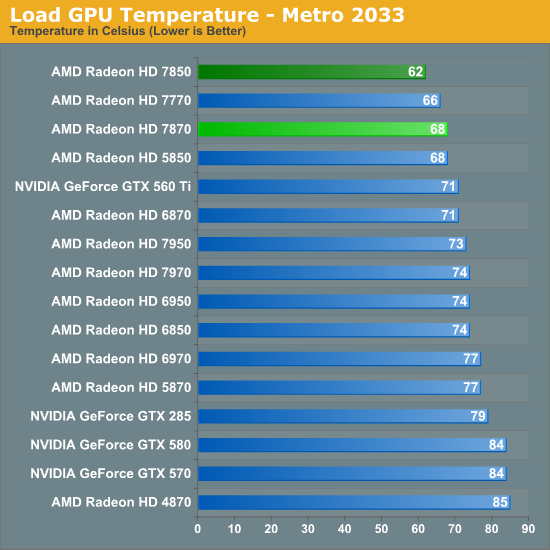
Under load, Metro temperatures are also quite good. At 62C the 7850 is the coolest card in this performance class, but keep in mind that it’s basically using an oversized cooler; retail cards will be open air coolers with much different characteristics. Otherwise at 68C the 7870 is still among the coolest cards, coming ahead of even the historically cool GTX 560 Ti, never mind the much hotter 6900 series.

Load temperatures climb under OCCT, but again the 7800 series is among the coolest temperatures we see. Here we see the 7870 peak at 73C, whereas its last generation counterpart would be at 80C and the GTX 570 at a toasty 87C.
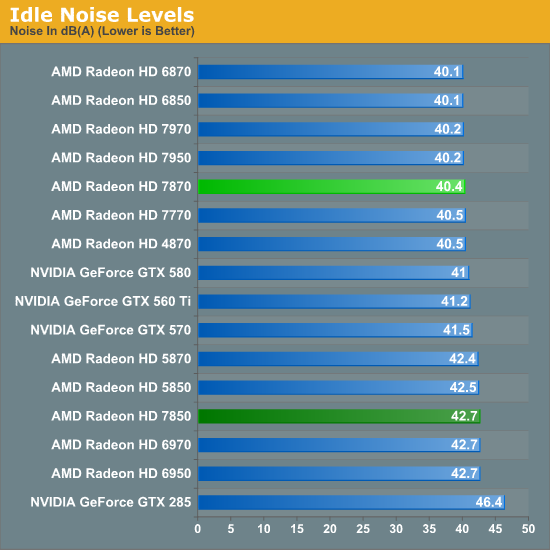
Moving on to noise testing, there are no major surprises at idle, with the 7870 hugging 40db. For whatever reason the 7850’s minimum fan state is roughly 200RPM higher than the 7870’s, but since no one will be using this cooler it’s not a significant result.
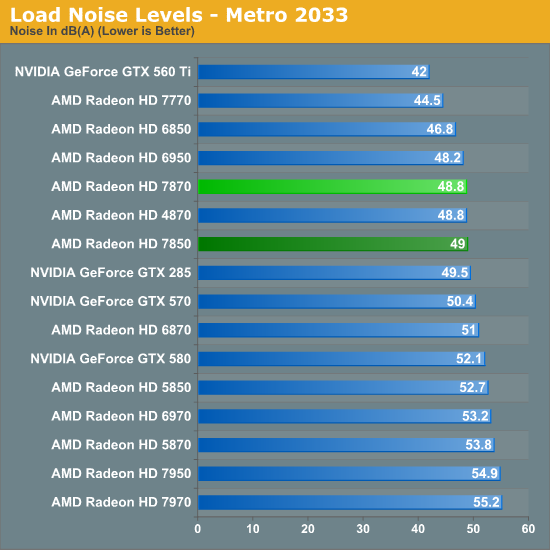
Consistent with AMD’s other 7000 series cards, we’re once again seeing the consequences of AMD’s aggressive cooling policies coupled with the use of a blower. At 48.8dB the 7870 is still quieter than the blower-based 6870, but it’s significantly louder than the open air cooled GTX 560 Ti, even though the latter consumes far more power and generates far more heat. This doesn’t make the use of a blower the wrong choice, but combined with aggressive cooling policies it does hurt AMD. The GTX 570, in spite of using much more power than the 7870, is only less than 2dB louder even though it too uses a blower.

Last, but not least we have our OCCT noise results. Unlike Metro the 7800 series does better on a relative basis here, but this is mostly because NVIDIA doesn’t have a power throttling system quite like PowerTune. At 51.9dB the 7870 is not the quietest card, but it still manages to beat the 6970 and the PowerTune-less 6870.
All things considered there are no great surprises here on a relative basis, as the 7800 series performs like we’d expect for a blower based sub-200W video card. Due to TSMC's 28nm process AMD greatly improves on their performance/power and performance/noise ratios with the 7800 series compared to the 6800 and 6900 series, while for their power class the 7800 series is slightly ahead of the pack on both power consumption and noise.
With that said, keep in mind that since most of AMD’s partners will be using open air coolers these results won’t be applicable to most retail cards. So for the temp/noise characteristics of retail cards you’ll want to look at individual card reviews when those start appearing later this month. This is particularly true for the 7950, where all of the retail cards will be using a different design than our sample.










173 Comments
View All Comments
Zumzifero - Monday, March 5, 2012 - link
I agree with you about some of your statements but not all.Price are too high and everybody seems to agree.
Then, if you are just aiming at performances I think you may find good use for some of those 69x0 still on shelves.
These 7xx0 cards have some use anyway: 7750 are great for all those budget HP and similiar you can buy in mega-store. You can play decently phasing out hose horrendous GeF 320 you get inside.
About apps supporting AMD vs Nvidia, I' may point out that recent NV drivers are castrated by choice with everything supporting a super expensive Quadro line, meaning you may find yourself much more comfortable with an obsolete GF260 then with a GT560ti. This does not applies for AMD that (as fare as it lasts) is not jeopardizing our effort to actually "work" on a "non pro" rig. I doubt you'd really need an HD7970 for Solidworks or 3DStudio (if you do, better go with a pro card), but if you spend several hours on a PC with these programs, I guess you may find interesting stuff like the much despised HD7850, which can play games, video, multi monitor systems and professional apps without killing you with the energy bill.
HD7970 may not be a wonder in terms of raw power (albeit being almost as fast as a 6990 or a 590) but it actually draws less then previous generations while being so much faster.
Still, prices are high, which I don't like, but, would you be the CEO at AMD, how would you have behaved knowing that, until Nvidia comes out with it's line costumers have no alternatives for PCI 3.0 and DX 11.1? they know they will be able to lower these prices substancially if needed.
I'm a causal gamer, and an architect, and the programs I need are not Quadro or FirePro certified so I can happily live with mainstream graphic cards. I'm using a GTX560ti but I plan to build a new rig based on Ivy Bridge 3770, ITX 2HD Raid 1, 2 SSD (one for HD caching) inside quite small Lian Li P08...
Since IvyB is not out yet I guess I'll wait and see what nVidia has to offer, but how bad do you think a 7850 would be in it?
Last but not least, US is not the world, and AMD sells globally: do you know how much higher are energy bills outside your country? You can find nfo on this site if you are interested.
Given the nVidia trend since GT200 serie (meaning horrendous power/speed ratio), I don't held my finger crossed about Kepler. I hope I'm wrong.
chizow - Monday, March 5, 2012 - link
Its not about the % of people who own those cards, its that those are the people who would most likely be in the market for one of these GPUs since they've already bought in that range.Anyone who bought a GPU in the last 24-30 months has very little reason to buy one of these cards as its really not offering any significant increase in performance that they couldn't have gotten at the same price points over the last 24-30 months. That's the problem.
Sure there's some power consumption benefits from these new parts, but that's usually just a by-product of the die shrink that's a bonus that's far lower concern than actual price and performance.
For someone buying their 1st GPU today yeah it makes more sense to buy this over an older part, but for the rest of the market, there's really no progress here with AMD's 7-series line-up.
Alpert - Tuesday, March 6, 2012 - link
I registered a account here just to reply to you, now don't you feel special. Well you should because you can't see that the 7870 is priced $200 below that of a GTX580. So I don't understand what you mean by saying"price/performance. Southern Island has been a huge disappointment so far".
That don't make sense, My only complaint is a miserable $20 that is the cards being $20 over priced.
Zoomer - Wednesday, March 7, 2012 - link
SI is about compute, not raw gaming performance. That's where much of the transistor budget went.The deep idle state probably didn't help as well. Wonder how much area that took. I doubt 7W in a desktop environment matters, as even in a crossfire setup, that's just 14 W. For laptops, sure. For dense compute clusters, maybe, if it's going to be idle.
steambuns - Monday, March 5, 2012 - link
Never expected them to be this fast!!they have not shown up with online stores yet, cannot wait to pick one up
$350 for the speed of $500 cards works for me.. 7870 in my future plans.
venomblade - Monday, March 5, 2012 - link
The 7870 looks perfect for me! Was kinda hoping for a $300 pricepoint, but for this kind of performance I'd be more than willing to shell out a bit more. And wow looking at the skyrim benchmarks when the vram made the fps crash was just daunting. At first glance I was wondering how could the 570 and up be two times faster than a 560 ti in Skyrim. Also, not a big deal but you put "GTX 570 ti collapses beyond 1920."jjj - Monday, March 5, 2012 - link
This is not even funny and the sad part is that AMD is being nasty and pullng the 69xx series since they were a better deal (the 6970 started at 300$ after price cuts and/or MIR).The entire 7xxx prod line is a huge dissapointment price wise,for now.
tynopik - Monday, March 5, 2012 - link
why don't you use the gpu benchmarks that people actually care about? bitcoin, F@H, even RC5-72also various elcomsoft and other password recovery tools use the GPU
Ryan Smith - Monday, March 5, 2012 - link
Hi tynopik;We've actually considered all of those programs, but we've rejected them for various reasons.
Bitcoin: Hand optimized assembly that works poorly with brand-new cards
F@H: Works poorly with new AMD cards. Also, difficult to benchmark
RC5-72:Hand optimized assembly that works poorly with brand-new cards. Also, it's basically a proxy test for a fast ROTL operation.
Password Tools: Basically a proxy test for having many simple shaders, and a proxy test for a fast ROTL operation
Basically with the possible exception of F@H, all of those programs are the same type of edge case for AMD's old generation hardware. Which is not to say that they're not important, but we don't pick our compute benchmarks just to evaluate the relative performance of video cards. We also pick them to better understand their architectures and their strengths & weaknesses; those benchmarks would not have told us much of value about Fermi or GCN.
kreacher - Monday, March 5, 2012 - link
I was also considering an upgrade from my 5850 and was waiting for 7800 series. Really disappointed to see the small performance gains after two generations.